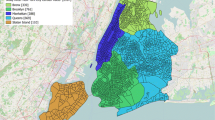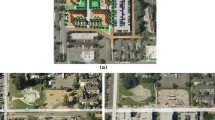Abstract
The major goal of this study is to help create more walking- and biking-friendly Transit-Oriented Development (TOD) policies by finding determinants that influence walking and biking to transit stations. Based on the station user survey conducted in Mountain View, California, two mode choice models are estimated for commuter rail users’ trips to the station. To find statistically significant factors that influence the probabilities of choosing walking over driving and also choosing biking over driving, two binominal logit analyses are performed with 40 travel, socio-economic, and built environment variables. The model I (walk vs. auto) analyzes 277 walkers and auto users living within 1.5 miles (2.4 km) of the station, while the model II (bike vs. auto) analyzes 280 bikers and auto users living within 2 miles (3.2 km) of the station. Both models share three predictors: trip distance, car availability, proximity to auto-friendly streets. This research also finds that trip purpose, race (Asian), intersection density influence transit users’ decision to walk over driving, while race (white) and gender affect their decision to bike over driving to the station.
Similar content being viewed by others
References
Ayvalik, C. and Khisty J. (2002). “Heuristic analysis of impacts of commuter rail station consolidation on pedestrian access.” Transportation Research Record, No. 1793, pp. 47–54.
Ben-Akiva, M. and Lerman, S. (1985). Discrete choice analysis: Theory and application to travel demand, MIT Press, Cambridge.
Caltrain (2012). Annual passenger counts between 2002 and 2012, Available at 〈http://www.caltrain.com/about/statsandreports/Ridership.html〉.
Cervero, R. (1995). Rail access modes and catchment areas for the BART system, Working Paper, Institute of Urban and Regional Development (IURD), University of California, Berkeley, California.
Cervero, R. (2001). “Walk-and-ride: Factors influencing pedestrian access to transit.” Journal of Public Transportation, Vol. 3, No. 4, pp. 1–23.
Cervero, R. and Duncan, M. (2003). “Walking, bicycling, and urban landscapes: Evidence from the san francisco bay area.” American Journal of Public Health, Vol. 93, No. 9, pp. 1478–1483.
Cervero, R. and Kockelman, K. (1997). “Travel demand and the 3Ds: Density, diversity, and design.” Transportation Research Part D, Vol. 2, No. 3, pp. 199–219.
Cervero, R., Sarmiento, O., Jacoby, E., Gomez, L. F., and Neiman, A. (2009). “Influences of built environments on walking and cycling: Lessons from Bogota.” International Journal of Sustainable Transportation, Vol. 3, No. 4, pp. 203–226.
Ewing, R., Schroeer, W., and Greene, W. (2004). “School location and student travel: Analysis of factors affecting mode choice.” Transportation Research Record, No. 1895, pp. 55–63.
Hsiao, S., Lu, J., Sterling, J., and Weatherford, M. (1997). “Use of geographic information system for analysis of transit pedestrian access.” Transportation Research Record, No. 1604, pp. 50–59.
Korf, J., Demetsky, M., and Hoel, L. (1979). Logit analysis of rapid transit access choices, Working paper, University of Virginia at Charlottesville.
Loutzenheiser, D. (1997). “Pedestrian access to transit: Model of walk trips and their design and urban form determinants around Bay Area Rapid Transit stations.” Transportation Research Record, No. 1604, pp. 40–49.
Schank, J. (2002). “Encouraging kiss-and-ride at commuter railroad stations.” Transportation Research Record, No. 1793, pp. 7–14.
Tanemura, Y. (1996). “Influences of station-area environments on access modes to BART stations.” Working paper, University of California, Berkeley.
Author information
Authors and Affiliations
Corresponding author
Rights and permissions
About this article
Cite this article
Park, S., Kang, J. & Choi, K. Finding determinants of transit users’ walking and biking access trips to the station: A pilot case study. KSCE J Civ Eng 18, 651–658 (2014). https://doi.org/10.1007/s12205-014-0073-6
Received:
Accepted:
Published:
Issue Date:
DOI: https://doi.org/10.1007/s12205-014-0073-6




